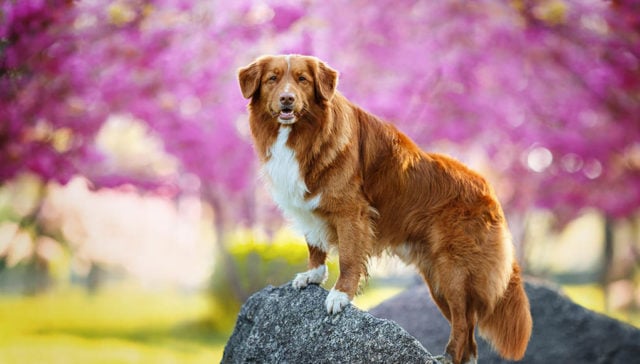
Table of Contents
- Nova Duck Tolling Retriever—But First, What is Tolling?
- History of the Nova Duck Tolling Retriever Dog Breed
- Physical Characteristics
- Nova Scotia Duck Tolling Retriever Temperament
- Toller Training and Exercise
- Nova Scotia Duck Tolling Retriever Health
- Grooming
- Frequently Asked Questions
- Nova Scotia Duck Tolling Retriever Dog Breed Summary
Are you struggling to pick a dog breed to adopt? Let's look at the Nova Scotia Duck Tolling Retriever.
Tollers are fun, energetic, intelligent, affectionate, and loyal. And if you're looking to adopt this kind of dog breed, it's important to learn about everything about them first.
These dogs can easily adapt to their surroundings. They're okay living in apartments, as long as their owners provide the required exercise for their breeds. If their exercise needs are neglected, it can cause unwanted behaviors and boredom.
In addition, if you're looking to adopt a Nova Scotia Duck Tolling Retriever puppy, it's still best to find a responsible breeder to ensure that you're adopting a healthy dog.
Below, we'll discuss their personality, diet, physical characteristics, grooming needs, and overall health of a Nova Scotia Duck Tolling Retriever a.k.a Tollers.
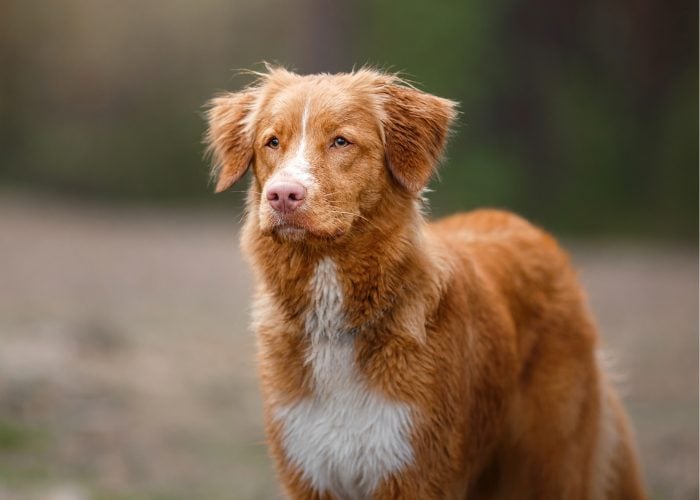
Nova Duck Tolling Retriever—But First, What is Tolling?
When it comes to the Nova Scotia Duck Tolling Retriever dog breed, you'll always hear the word “tolling” or “toller”, so why is that? What even is the meaning of tolling?
Well, toller came from the word tollen which means “to entice” in Middle English. Tolling is the act of luring and it's what the Nova Scotia Duck Tolling Retriever does.
History of the Nova Duck Tolling Retriever Dog Breed
Originally, Tollers were foxes. Canada's Micmac Indians observed foxes luring ducks from the shores of rivers and lakes, then snatching ducks that were to come too close.
This gave the Micmacs an idea to teach this tolling behavior to their dogs.
Long ago, in the 19th century, hunters in England and Canada trained dogs to go into the water to fetch back downed birds. These dogs are called Retrievers.
They bore the names of the places where they were developed, for instance, Labrador and the Chesapeake Bay.
However, things were a bit different from the hunters in Yarmouth County in southwest Nova Scotia's Little River district.
Hunters in this area created a dog that would attract birds and retrieve them as well. They became known as the Little River Duck Dog.
These dogs weren't famous back then, but in 1984, the Canadian Kennel Club recognized this breed and gave them a new name: Nova Scotia Duck Tolling Retriever.
On the other hand, the first Toller to come to the U.S. was in the 1960s. But they were not that popular at first. It started to gain fans that by 1984, the Nova Scotia Duck Tolling Retriever Club USA was formed.
It was not until the year 2001 that The American Kennel Club accepted this breed in the Miscellaneous Class and into the Sporting Group in 2003.
Physical Characteristics
Height and Weight
A male Nova Scotia Duck Tolling Retriever stands about 18 to 21 inches tall at the shoulder and a female Toller can stand at around 17 to 20 inches, but their ideal height is 18 inches.
On the other hand, Tollers' weight is in proportion with their height. They weigh around 35 to 50 pounds.
Coat
The Nova Scotia Duck Tolling Retriever has a medium-length coat. However, it is low in maintenance and it's easy to take care of. Their double coat is also water-repellent.
Their red and orange coat color gives them a fox-like appearance. This adds to the theory that Tollers are a fox-retriever cross, which is a genetic impossibility.
In addition, tollers have white markings on their feet, chest, face, or tail tip. Hunters preferred when they have white markings on the tip of their tails so it'll be easier for them to spot them from a distance.

Nova Scotia Duck Tolling Retriever Temperament
As mentioned earlier, Tollers are intelligent, independent, and curious. Their personality is like a mix of a Golden Retriever and a Terrier.
They generally have an upbeat attitude. And if they're not playing or working, they love to just chill and be quiet. Typically, adult Tollers are gentle dogs, especially with children.
Tollers can also easily adapt to their environment. They do okay with crate training and travel.
However, they can be aloof to strangers, but they take their signals through their owners. For example, if you're friendly towards that said stranger, your Toller will ease up a bit and be friendly too.
The Nova Scotia Duck Tolling Retriever dog breed is a decent watchdog. They watch everything that's going on in their surroundings and will alert you if someone is approaching.
Similar to every other dog, Tollers need to be trained in socialization early on. Even though they typically get along well with other animals, it's still best advised to look out for occasional aggression.
If a toller is not properly trained to socialize, they can be aggressive.
A negative trait that you'll probably see is when they are left alone all day, they tend to excessively bark, dig, and chew. However, this could also mean that they have separation anxiety.
Toller Training and Exercise
Training
When it comes to training a Toller, positive reinforcement is the main key. The Nova Scotia Duck Tolling Retriever is a breed that doesn't work well under pressure.
Do not be harsh, and do not get easily frustrated. Also, they need to be praised and be given rewards when they do a successful task.
A Toller learns quicker and easier when they are motivated and generally happy.
It is best advised to start training your toller puppy as soon as you bring them home. It's okay to start training even at around 7 to 8 weeks old because even this early, they'll be able to comprehend the things you teach them.
Puppy tollers will test you and see what they can and can't get away with. In addition, starting early can also help build a strong working relationship.
Exercise
Adult Tollers need moderate exercises. If you live in the city, Tollers thrive on twice-daily walks and playing in the dog parks.
For instance, schedule a 30-minute walk or run session with him or a 30-minute walk and a 30-minute playtime to burn off their energy. Remember that a tired Toller is a happy Toller.
However, it's a different story when it comes to Nova Scotia Duck Tolling Retriever puppies. Toller puppies are full of energy and are highly active but as they grow older, their energy level will be much more manageable.
In addition, the Nova Scotia Duck Tolling Retriever dog breed likes to swim. This can also be part of their exercise where you can bond with them and socialize with other dogs.
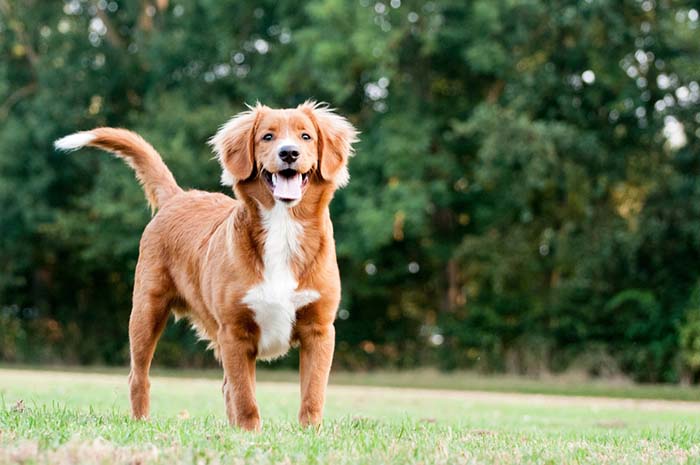
Nova Scotia Duck Tolling Retriever Health
The Nova Scotia Duck Tolling Retriever breed is generally healthy. But like all breeds, Tollers are prone to certain health problems.
That doesn't mean that they'll experience any of these health issues, but as the dog owner, you have to be aware if you're looking to adopt this kind of breed.
A few of these diseases are:
Hip Dysplasia
There are a lot of Retriever breeds that are prone to hip dysplasia. This includes Labrador Retriever, Golden Retriever, and the Chesapeake Bay Retriever.
So what even is hip dysplasia? It is a heritable condition where the thighbone doesn't fit into the hip joint.
It could be hard to determine if a dog has hip dysplasia because some don't show any signs of discomfort.
But if your pup is showing pain and lameness on one or both rear legs, it would be best to have them checked up.
Since this condition is hereditary, a dog suffering from hip dysplasia mustn't be used to breed.
This is why researching and looking for a reputable breeder is crucial when it comes to adopting a dog. A responsible breeder can give you the full health background of the dog's parents.
Ask them for proof that the pup's parents have been tested for hip dysplasia and are free of any other health problems.
Hip Dysplasia can also be worsened by a high-calorie diet or injuries from jumping or falling on floors.
Progressive Retinal Atrophy
Progressive Retinal Atrophy or PRA is a severe eye condition in dogs that gradually leads to blindness. It is one of the hardest dog eye problems to spot due to the lack of symptoms.
The first symptom of PRA is night blindness, and after that, poor overall vision. Monitor your pup.
If you see them tripping over things or unusually bumping into furniture or walls, these could be signs that they have poor vision or even PRA.
Just like hip dysplasia, Progressive Retinal Atrophy is a genetic disorder. It all comes down to responsible breeding.
Unfortunately, there are no effective treatments for PRA in dogs. However, it's safe to say that this eye problem is painless and usually, dogs can adapt well to going blind.
Collie Eye Anomaly
As the name suggests, the Collie Eye Anomaly is usually found in Collie breeds. However, this eye condition has been seen in the Nova Scotia Duck Tolling Retriever in the last few years.
This condition usually happens by the time the dog is 2 years old and is diagnosed by a veterinary ophthalmologist.
Just like in Progressive Retinal Atrophy, there is still no treatment for CEA. Fortunately, dogs can still live well using their other senses.
It still all comes down to proper breeding since this is a genetic abnormality. Make sure to spay or neuter your dog to prevent the gene from being passed on to the new generation.
Grooming
The Nova Scotia Duck Tolling Retriever dog breed is a wash-and-go type of dog. Throughout the year, their coat generally only requires weekly brushing to keep the fur from matting and to remove dead hair.
But keep in mind that daily brushing could be necessary once the spring and fall shedding season comes.
Generally, just keep their nails trimmed, clean and trim their foot pads, and clean their ears if needed.
However, when it comes to their teeth, you should at least brush your Toller's teeth about two or three times a week to remove tartar buildup or any bacteria that might be lurking inside their mouth.
Daily tooth brushing is also not a bad idea to help prevent gum disease and bad breath.
It would be best to start a few of these grooming processes while they are young and ensure that grooming is a positive experience.
Give them treats and rewards, and remind them what a good boy or girl they are.
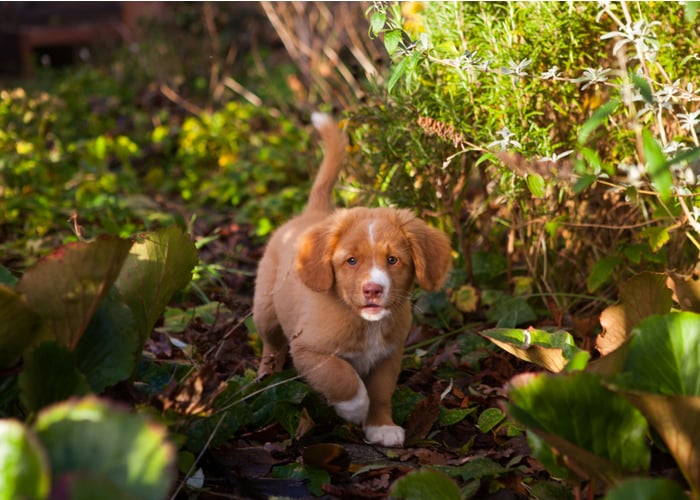
Frequently Asked Questions
Are Nova Scotia Duck Tolling Retrievers good family dogs?
When it comes to kids, Tollers love them. They make a really good playmate for playful older children.
They can play ball with them, teach them tricks like fetch, or even just keep them occupied. However, they might be a bit too rowdy for very young children.
As the pet owner, you have the responsibility to supervise not just your dog, but also teach your children how to properly play with your pup. Educate them on how to approach and touch your dog.
Tollers are also fine with other dogs as well as with cats, specifically if they're raised together.
Is a Nova Scotia Duck Tolling Retriever rare?
Yes, Tollers are indeed rare breeds. If you're looking to adopt a Nova Scotia Duck Tolling Retriever, it may take you 6 months or even a year to find a reputable breeder for a Toller Puppy.
However, you can also adopt a toller from rescue groups instead of a breeder. Two examples of this are the Nova Scotia Duck Tolling Retriever Club (USA) and the Nova Scotia Duck Tolling Retriever Club of Canada
Do Nova Scotia Duck Tollers shed a lot?
Yes, Nova Scotia Duck Tolling Retrievers shed a lot of their double coat fur, especially in the Spring and Fall season.
As the dog owner, you must be prepared to do extra cleaning and more extensive grooming when this happens.
Having the right equipment can make your life easier. The right grooming tools will make it more efficient for you and the dog.
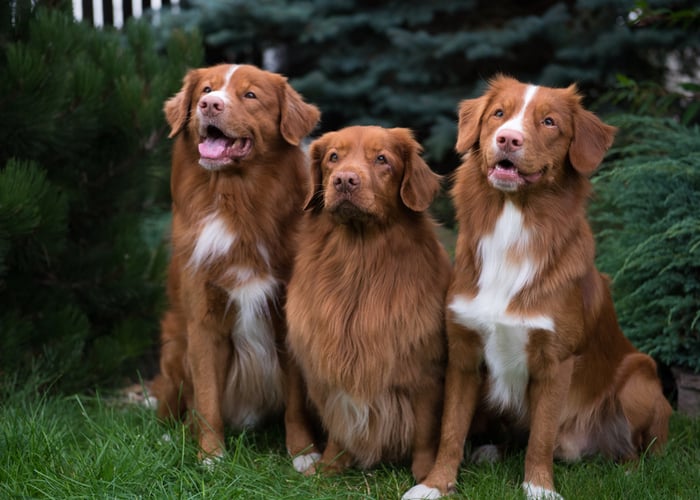
Nova Scotia Duck Tolling Retriever Dog Breed Summary
The Nova Duck Tolling Retriever dog breed is an intelligent, outgoing, and affectionate kind of Retriever. Tollers are medium in size, bone, and coat length.
This kind of dog is recommended to people who also have lots of energy to keep them occupied. So if you love running, hiking, camping, and swimming, Tollers might be the dog for you.
If you're looking to adopt a Nova Duck Tolling Retriever puppy, thoroughly research for a reputable breeder that can give you the complete health record of their parents to know any genetic conditions that might've been passed on.
But all in all, if you're looking for smart, loving, and beautiful companions, the Tollers might be the pup for you!
READ NEXT: LABRADOR RETRIEVER BREED PROFILE












